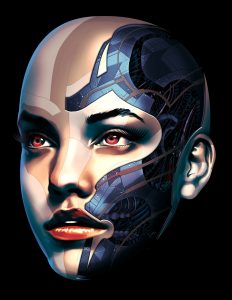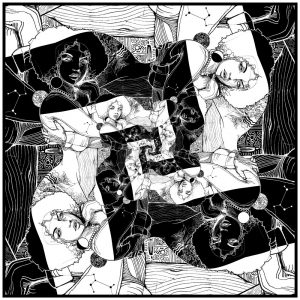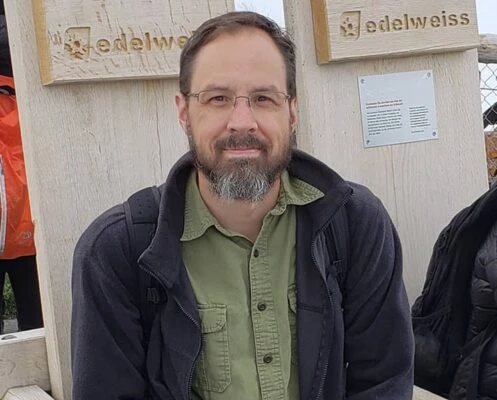
This month’s Apex Magazine cover artist is Billy Nuñez, a versatile artist working with many styles and designs. From science fiction and portraiture, through comics and digital art, Nuñez brings forth fascinating characters and worlds.
APEX MAGAZINE: Your cover art for December’s Apex Magazine is one in a series of images called “Future Face,” and the video within the gallery on your site shows the process of creating one of the paintings. How much of the mechanics behind the face do you have worked out ahead of time, versus creating them on the fly?
BILLY NUÑEZ: It’s mostly created on the fly but some parts I think of ahead of time because of how important it is to the structure. I usually look at the insides like it’s the skull so certain parts like the eye and the mouth area need to be a certain way to make sense. The portraits are very realistic so certain things about the interior need to be realistic too. So having a space where the eyeballs fit makes sense, so does having realistic teeth. The rest of the interior I make it up, focusing on making it look cool rather than realism since that’s what you can’t see. These are the rules that I have set up for this series, which I can then play with later additions to the series.
AM: Many of our cover artists post either videos or images of their creations in progress, both for the public and to learn about their own processes. Does recording a piece as it is being created influence the work at all, or create any good or bad self-conscious feelings as you work?
BN: It does make me more self-conscious about certain things. There’s things that look simple enough to do that might take way longer than I expected and sometimes I might want to cut out some of that from the video out of feeling embarrassed, even if it’s something no one would notice or care about. Things like this are both good and bad in that it makes me step up my game while painting, but sometimes might make me too tense when I should loosen up. These videos give me the same feeling as when I’ve painted in public with people walking by. Those self-conscious feelings are just something you have to deal with as with any social interactions in life.
AM: On your website, you have a series called “People,” and another called “Girls,” with different concepts of painting styles and realism versus exaggerated bodies. It reminds me of artists like Honore Daumier, known for both his realism and caricature-related styles. Do those ideas ever conflict when you are coming up with a piece, or is the idea fairly sound in the process?
BN: The people series is mainly general portrait work and the “Girls” are mainly female “pin-ups,” which are more erotic in theme. The portraits I have now are mostly realistic because they are all using photo reference and I wanted to keep the look of the photos as they were. The “Girls” are mostly exaggerated and stylized because most of those are done from my imagination. That’s just the way I have them so far but I’m not opposed to having realistic or stylized pieces in either series.
AM: Your website features the “Monstas in the Basement” video that you directed and animated. How does that experience affect your more recent creations, as far as your processes, ideas, or approach?
BN: Making that video was an interesting process because I’ve never filmed anything like that where I had to direct performers, set up lighting, etc. Most of my work is just me on my own, sometimes taking direction from a client. The video hasn’t affected too much of my new work but I do have videos that I plan on doing where that video has prepared me for. It was a great learning process that will help me in future work.
AM: The “Gēn” gallery on your website features a fascinating look at patterns and depth. How is the approach to one of these pieces different than a looser, more general painting style?
BN: I like to experiment with all the possibilities of digital illustration and this series is one of those times where I figure something out that I want to explore with many more pieces, which is how it becomes a series. In the “Gen” I wanted to make repeat patterns that could work well as prints for fabrics. The drawing process is pretty loose and could be anything I want really. The difference between this series and a general painting style is that the piece doesn’t come together until I scan the drawings and start copying and pasting it around in different ways until I’m happy with the results. Unlike most paintings where I can see the finished product in my head, I don’t know what these pieces will look like while I’m drawing the elements that will be duplicated later. Once I start copying and pasting, it’s fun seeing what comes out of my drawings that I wasn’t even imagining. The computer becomes almost like a collaborator in the piece.
AM: Thank you, Billy, for letting us have a look at your artistic process. See more of Billy Nuñez’s art on his website at billynunez.com.












